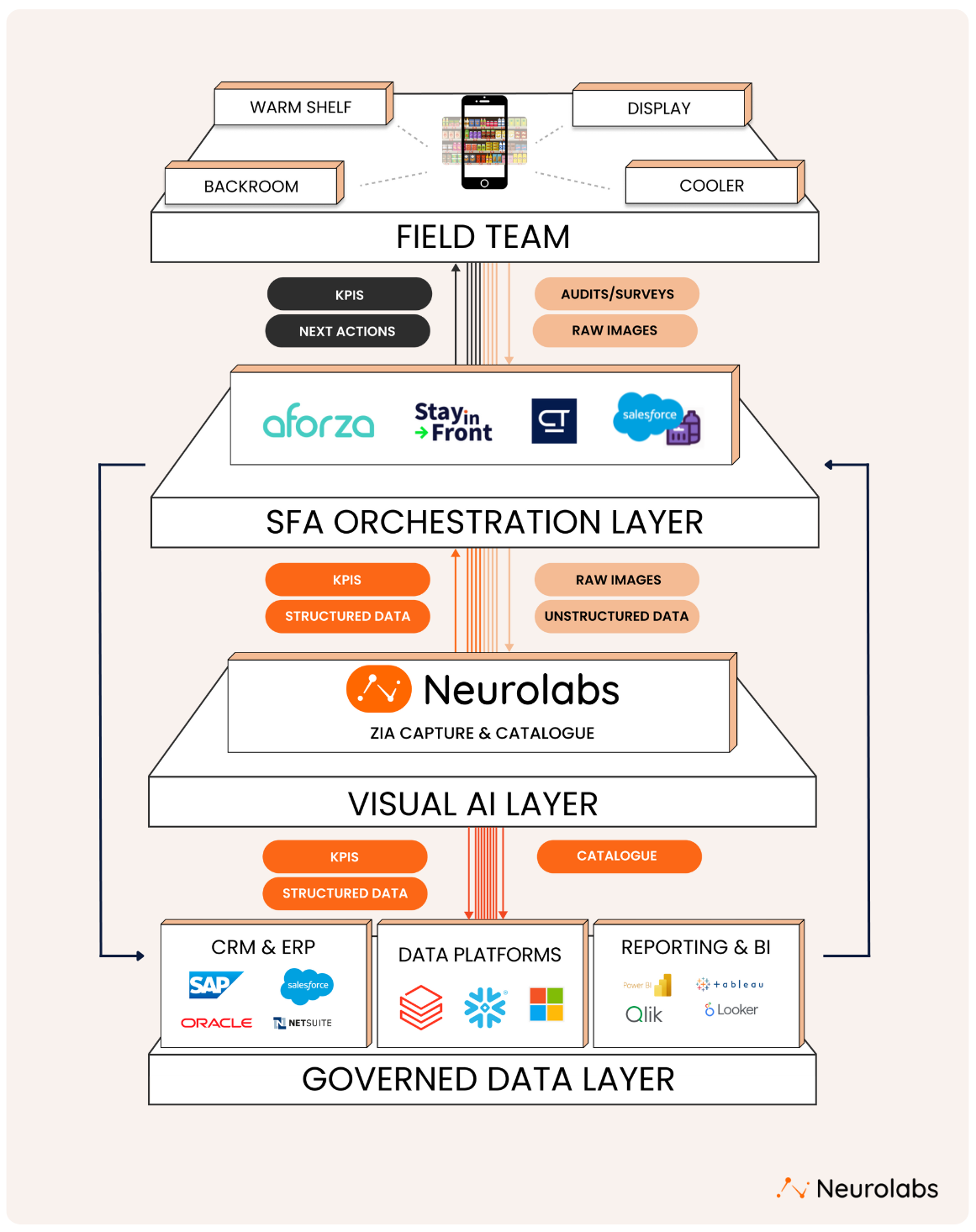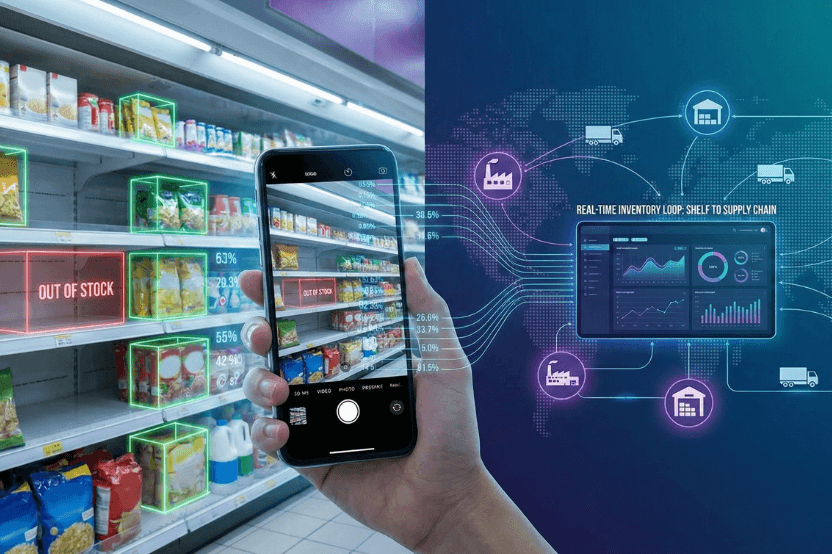Contents
The CPG (Consumer Packaged Goods) ecosystem is experiencing a profound shift. As data and AI become more accessible, brands are moving past siloed applications toward a more integrated, data-native approach. The goal is to collapse the distance between insight and action, especially when it comes to retail execution technology. In my view, this strategic shift is critical for building a future-proof CPG tech stack.
This piece will explore the technical ecosystem, profile the key players and show how the strategy of bringing apps to data fits into an integrated approach. Finally, I’ll explain why Visual AI is becoming a core pillar in this stack and how we at Neurolabs fit in.
The Evolving CPG Ecosystem
The battlefield for CPG brands isn’t in the boardroom; it’s on the store shelf. The stakes are higher than ever, with complex supply chains, national promotions and distributed field teams all culminating at the point of purchase. To win, brands build layered tech stacks for everything from demand forecasting, trade promotion, field execution, master data management and real-time analytics to field execution tools. This can add capability, but it also create friction.
The most progressive brands are adopting a first-principles thinking and composable MACH architecture (microservices, API-first, cloud-native, headless) to unify these disparate parts [1]. This foundation is what allows for the seamless integration of new tools and faster adoption. With this in mind, let's look at the key players that form this new landscape.
Sales Force Automation (SFA): The Eyes in the Field
Field teams rely on SFA apps to execute on-site tasks, from capturing photos and audits to placing orders during store visits. These apps provide reps with real-time KPIs and "next best actions" to fix issues on the spot. Structured store data then flows up to RGM (Revenue Growth Management), TPM (Trade Promotion Management) and other commercial teams, informing their decisions on pricing, assortment and promotions. It’s this two-way feedback loop that connects shelf visibility to HQ strategy.
Notable SFAs include:
- Aforza - CPG-native SFA with embedded AI guidance (AVA), visit planning, audits, order capture and KPI tracking for commercial teams.
- Salesforce Consumer Goods Cloud - Enterprise SFA on the Salesforce platform for visit planning, surveys/audits, retail execution, guided actions and HQ-to-field data flow.
- StayinFront (TouchCG) - Full retail-execution SFA for CPG (audits, ordering, guided selling), with StayinFront Retail Data Insight (RDI) for data-driven in-store prompts and alerts.
- CustomerTimes (CT Mobile) - Native Salesforce retail-execution app for field reps: visit planning, mapping, guided execution and ordering; integrates with Salesforce CG Cloud.
- Spring Global - CPG focused retail execution (SFA) platform that orchestrates visits, audits, orders and tasking with command centre visibility. It’s built to close the gap between HQ strategy and shelf execution.
Master Data Management (MDM) and the Unified Data Layer
CPGs rarely rely on a single MDM product. Instead, they build a robust operating model on top of a unified data platform. This is a centralised layer with clear ownership, governance, quality rules, lineage and controlled publishing of "golden” product, store and customer dimensions to the apps that need them.
In most organisations, a Customer Relationship Management (CRM) system like Salesforce acts as the customer master. It governs accounts and contacts, either publishing the "golden record" to the data lakehouse or consuming it to keep front-line teams aligned. For product, supply and financial data, an Enterprise Resource Planning (ERP) system such as SAP or Oracle remains the system of record. These systems push authoritative data, like pricing, vendors and product hierarchies, into the analytical platform and receive enriched attributes back as part of the feedback loop.
The real centre of gravity for analytics is a modern Data & AI platform (Databricks, Snowflake or Microsoft’s stack). This unified layer enforces data quality, lineage and governance, distributing mastered data as a governed product. Platforms like Crisp accelerate this process by aggregating and harmonising retailer and distributor feeds, POS, inventory and DC, delivering clean data into the lakehouse. [3] From there, the mastered data flows to downstream tools like retail execution tools and Business Intelligence (BI) platforms (Tableau, Looker, Power BI) to drive action and reporting.
The Real Strategic Shift: From Apps to Data
The real strategic shift in CPG stacks is that applications are moving to the data layer.
Historically, business and engineering lived in silos, slowing the path from raw data to decisions. A unified data layer, with fine-grained permissions and quick ways to build specialised data apps, lets teams work end-to-end.
This isn't theoretical:
- Snowflake’s acquisition of Streamlit brought interactive data app building directly into the warehouse, shrinking the gap between idea and deployment. [4]
- Databricks introduced Databricks Apps so teams can build and run secure, serverless data and AI apps right next to governed data. Paired with AI/BI and LakehouseIQ, it’s a push to “talk to your data” and turn the lakehouse into a real-time business layer. [2, 5, 6, 8]
- The SAP x Databricks partnership is a prime example of ERPs rethinking where value lives, moving it closer to the lakehouse. They announced a deep partnership making Databricks part of SAP’s Business Data Cloud, backed by a $250M adoption fund. [2]
Framed through that lens, Visual AI should be data-native too. Its outputs land directly in the governed data layer (Databricks/Snowflake/Fabric), inheriting platform security and lineage, and are exposed as data products and lightweight apps business users can operate. Upstream data-exchange platforms like Crisp then feed retailer/distributor POS and inventory data into the same layer for faster and richer analytics, while downstream consumption happens in retail execution tools and BI (Tableau/Looker/Power BI) to drive action and reporting. [7]
This ensures the insights from Image Recognition (IR) analysis are not locked in a static report, but are a first-class data product ready to be actioned.
This is where agentic AI comes into play. The next step is making the lakehouse conversational and action-oriented so teams can “talk to the data” and trigger actions. Vertical assistants, like Aforza’s Ava, use domain-specific agents to guide frontline reps, while Databricks’ AI/BI Genie lets users ask questions in natural language directly on governed data. This approach minimises the distance between insight and action: fewer hand-offs, less BI bottlenecking and faster store-level decisions, all within the same governed data layer.
In practice, that means planners, sales and RGM teams get answers (and suggested next actions) in minutes, not cycles, accelerating promo execution, shelf fixes and post-event readouts while improving adoption across non-technical users.

The Emerging Role of the Visual AI Layer
By turning real-world shelf images into structured data, a Visual AI layer provides an objective, real-time view of execution. It acts as the connective tissue, linking a plan to performance and enabling every layer of the ecosystem to respond faster and smarter.
High-quality IR data, powered by synthetic data, feeds two main agentic surfaces that turn shelf visibility into action:
- Field Agents: In SFA apps, these agents surface "next-best actions" for reps, like suggesting a missing product, auto-filing tasks, or generating a checklist to fix non-compliance issues all while they’re in-store.
- Data-Layer Agents: For commercial and leadership teams, these agents answer natural-language questions ("Which retailers had low display compliance last week?"), run multi-step diagnostics and propose actions (reallocate spend, tweak mechanics, retarget stores), while BI and planning teams (RGM/TPM) use the same signals to quantify compliance and lift; Supply Chain uses them to mitigate over/under-stock.
This approach compresses the loop: detection → decision → action.
The data from image recognition isn’t just a report; it's a foundation for intelligent automation.
How That Plays Out in the Store
Let’s imagine a national "2 for £3" promotion on a 500 ml energy drink. The plan details, including facings, price and signage are published to the governed data layer.
- In-Store Capture → IR Facts: A field rep snaps a photo of the aisle. The image recognition technology, powered by our synthetic data, returns structured facts in near real-time, mapped to the master data:
- “Display present: No”, "Facings: 6/12," "Price label: 2 for £4 (non-compliant)," and "Promo signage: Missing."
- Orchestrated Action: The SFA's agent, using this IR data, presents a checklist to the rep:
- "Add 6 more facings," "Correct the price ticket," and "Place signage." The rep completes the tasks and the SFA auto-files and closes them.
- Propagate and Verify: A quick rescan confirms compliance. These time-stamped facts flow back to the data layer, automatically rolling up to relevant teams. RGM/TPM can now correlate compliance with sell-through, Supply Chain gets an alert to bump the next delivery, and Key Account teams see the execution status without manual reconciliation. The result is a massive improvement in trade promotion ROI. For more on this, you can read our other blog on How Leading Brands Unlock Significant ROI from POS Displays.
How We, Neurolabs, Fit Into This Ecosystem
At Neurolabs, we provide the Visual AI layer that turns shelf images into governed, structured facts in your data layer. Our outputs, from granular, event-level data to curated data products, power both retail execution technology and commercial workflows.
We believe that because our outputs land in your data layer, they inherit your security, lineage and governance. SFAs can apply agentic AI to our Visual AI signals to surface next-best actions and capture proof-of-correction, while data teams join those signals with CRM/ERP and retail feeds to drive RGM/TPM decisions, forecasting and post-event readouts. Crucially, we don’t lock insight behind static reports. You get programmatic access via APIs to power bespoke data apps and automations at your own pace. The use of synthetic data and digital twins allows us to deliver this real-time shelf visibility with unmatched speed and scalability, empowering you to gain a crystal-clear view of your store execution everywhere, every day.
The New Bedrock of CPG Execution
Image recognition isn’t a bolt-on feature; it’s foundational. By providing a real-time, objective view of execution, it connects fragmented workflows, compresses the loop from detection → decision → action across retail and commercial teams and grounds decisions in reality. As agentic AI and data-app platforms mature, an integrated, data-native IR layer becomes the bedrock for faster, more accountable CPG execution. This is how we see the space today and we believe it's a critical work in progress.
A Note from Patric Fulop, Co-Founder & CTO of Neurolabs
I hope you enjoyed this piece on how the future of the CPG tech stack is being shaped by a new, integrated approach. If this article sparked a thought or a question for you, I'd love to continue the discussion. You can connect with me on LinkedIn to share your views.
You can also request a demo of our Image Recognition technology that’s delivering real-time store visibility through synthetic data and digital twins to power fast, scalable and accurate retail execution technology.
________
Sources
[1] Ready for the Future? CPGs Can’t Overlook the Importance of Modern Tech Infrastructure, ConsumerGoods.com, 2024. https://consumergoods.com/ready-future-cpgs-cant-overlook-importance-modern-tech-infrastructure
[2] Introducing SAP Databricks, Databricks, 2025. https://www.databricks.com/blog/introducing-sap-databricks
[3] Essentials vs. Extras: CPG Tech Stack Guide 2025, Crisp, 2025. https://www.gocrisp.com/blog/essentials-vs-extras-cpg-tech-stack-guide-2025
[4] Democratizing Data Apps — Snowflake to Acquire Streamlit, Snowflake, 2022. https://www.snowflake.com/blog/snowflake-acquires-streamlit/
[5] Introducing Databricks Apps, Databricks, 2024. https://www.databricks.com/blog/announcing-databricks-apps-build-and-run-secure-data-ai-apps-lakehouse
[6] Introducing AI/BI: Intelligent Analytics for Real-World Data, Databricks, 2024. https://www.databricks.com/blog/introducing-aibi-intelligent-analytics-real-world-data
[7] Crisp: retail/distributor data exchange feeding the lakehouse. https://www.gocrisp.com/
[8] Databricks Data Apps - A strategic shift-right to close the analytics loop, Towards Data Engineering, 2025. *https://medium.com/towards-data-engineering/databricks-data-apps-a-strategic-shift-right-to-close-the-analytics-loop-16eac2614093*




